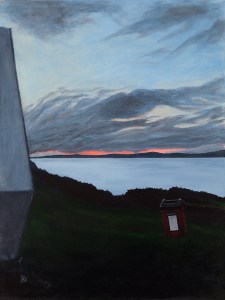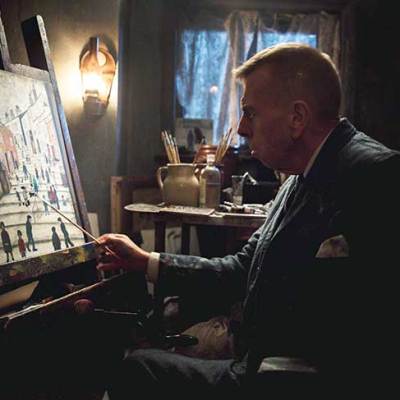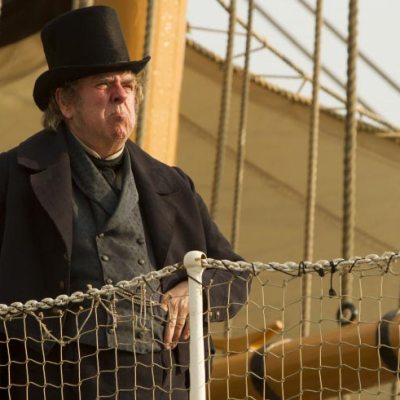The actor Timothy Spall has a knack for playing artists – in the role of Turner himself in Mike Leigh’s Mr Turner (2014) and more recently as L.S. Lowry in Mrs Lowry and Son (2019). Now he has discovered his own painting style – but to do so, he tells Apollo, he had to banish the ghosts of the great painters he has impersonated on screen.
Your first solo show, ‘Timothy Spall: Out of the Storm’, opens at Pontone Gallery in Mayfair next month. How did you become a painter in your own right, as it were?
Being a new artist but an old bloke, it’s a long journey. It kicked off through my work during the preparation – which was two years before we started – on the film that became Mr Turner. When you work with Mike Leigh the film comes out of the rehearsal period – the research and work that goes into it is as much a part of the film as what you see at the end. I was introduced to Tim Wright, who’s a very talented artist and teacher, because Mike Leigh wanted me know what it was like to be an actual painter. Tim gave me an old-fashioned sort of foundation course, where I did all the different disciplines and various mediums – watercolour, oil and drawing and en plein air and life drawing, and I did a take on one of Turner’s masterpieces, Steamboat on a Harbour’s Edge. We set up a studio like a Turner studio, too. I carried on painting a little bit after that film, and then I stopped.
So when did you pick it up again?
Five years later I was asked to play Lowry. I didn’t have any more tuition but I started painting. And then I couldn’t stop. I just painted all the way through that: every time I went back to my dressing room or my trailer I painted, and I painted in the evenings. A lot of it was takes on Lowry, but then something else started to appear. When I finished the job I paused a little while, and then – I had never used acrylics before, but I started using acrylics, and I found that liberated me. After I’d jettisoned all this competition with these two geniuses, you know, once I got rid of the spectre of their genius, I ended up starting to paint what I felt was something, that wasn’t just in somebody else’s image.
Dying of the Lake Light (2021), Timothy Spall. Image: courtesy Pontone Gallery; © Timothy Spall

How did the show come about?
The Lowry Gallery [in Salford] had a little exhibition about the making of Mrs Lowry and Son and they included my paintings. Domenic Pontone, who represented Tim Wright, happened to have one of his artists living there and he popped in and saw it and he offered me this opportunity. I was both excited and terrified, and thinking ‘My god, what do I do here?’ You know, way, way back there was a time in my life when – I think I’ve said it before – I didn’t know if I was going to join the army or go to art college, when I was about 16. Then I did the school play: that went well and the drama teacher advised me to be an actor.
I saw a documentary recently about manatees, and I didn’t realise that the manatee and the elephant are related – somewhere along the line they split in the gene pool, and one became an elephant and one stayed a manatee in the water. That’s what it feels like for me: for me the manatee, the artist, was always in the water and then the artist and the actor split. Now all of a sudden it’s come back, this unrealised creature in me that I thought was never going to come out has all of a sudden crawled out of the sea. Forgive the imagery, but that’s all I can equate it with really…
The paintings you’ve produced for the show are a mixture of landscapes and seascapes. Are these real or imagined?
They’re a mixture of the two really. Everywhere I go, and every time I go out, I’m always taking pictures: a mixture of things that seem to relate to what I’m feeling and what I think makes for a bizarre juxtaposition against that – or just something that catches me as an image. I snap it on the iPhone, and then I store it up.
Heaven Beyond the Shit-Bin (2021), Timothy Spall. Image: courtesy Pontone Gallery; © Timothy Spall

I’ve had the privilege of having travelled a lot in my work and through boating. I know what it’s like to be at rough sea and then come back and have the pleasure of seeing a sunset against a dog-shit bin – sometimes your mood is more akin to the dog-shit bin than the sunset. It’s something that you can’t explain that you’re feeling, and you can’t explain why it’s somehow related to the image that you’re seeing, but in the process of looking at it, thinking about it, digging it out, then it becomes its own thing.
Speaking of juxtapositions, a recurring subject in your paintings is the contrast between natural and man-made environments. What draws you to these landscapes?
I’m standing looking out of my window now, looking across the top of this western part of the city, and I can see the sky, and I can see some shitty bits of industry, and I can see about a thousand different colours, even in the grey there’s about 20 different shades of grey (that sounds like the film!) and even in the blue I can see seven different shades beyond that… We are the weather, to a certain degree, we are influenced by it; the elements are constantly changing the same way our bodies are constantly changing.
Talking about that mixture of the banal, the quotidian and the infinite sounds sort of hifalutin – but it’s practical as well. It’s only when you try and render it in a sense, that you really think about it: what is this? And in the process of trying to render it, what does it become? It becomes itself, it becomes its own thing. Because I do all my work in the studio as opposed to en plein air, then it becomes a debate between you and that feeling, and the practicality of getting it down and whether you’re going to bollocks it up in the process or whether you’re going to dig it out in the process.
Washing Worships as Day Declines (2021), Timothy Spall. Image: courtesy Pontone Gallery; © Timothy Spall

What is the actual process of painting like for you?
I don’t find it a particularly relaxing thing – it’s not a thing that I do to get away from acting. It’s almost akin to it in a bizarre way, because it feels as difficult. I don’t take myself seriously but my work I’ve always taken seriously, whatever form it takes, and I’m very, very critical. I don’t think of anybody else or any other artists – what I have discovered is there’s a lot of balderdash spoken about the process. Ninety-nine per cent of the effort just goes into getting it there, doing it. I learnt that from having investigated Turner and Lowry a bit – two very different people and two geniuses in their own right – you realise actually that this is a grunt-work thing, there’s a lot of just graft in it. The times I’ve ended up just in the foetal position thinking, ‘What am I doing? This is preposterous.’
With the exhibition, Domenic Pontone wanted it all to be new work. The pandemic – as ghastly for the world as it was and continues to be – came along and I found myself trapped with this commitment. I knuckled down, painted from morning till night, seven days a week, for six months and carried on afterwards. Even when I stopped, I was going back, I was fiddling with them.
Even if you’re not thinking about them while you paint, which painters are you particularly drawn to?
I love Turner. I grew to love him more and more. And, you know, because I don’t live far from St Paul’s, after we finished the film I went down and said sorry to him at St Paul’s a few times and I hoped it was all right and I didn’t get any feelings of reproach from him. The painting that I copied, Steamboat on a Harbour’s Edge, I’ve got up on my wall as a memento. I love that painting, I could look at it over and over again. Max Ernst I also love: I find him very disturbing, I love his technique. But also in the Wallace Collection, there’s a self-portrait of Rembrandt and on the other wall there’s a portrait of his son Titus, when Titus was a young man. You can see this love in his eye when you look at Titus. I burst into tears every time I walk by them.
One of the first things I saw as a kid which fascinated me was an illuminated lampshade that had a waterfall on it. I must have been about three. They were very big in the late ’50s: kind of naffarama really. But there’s some cheap art and some imagery as well that is as valid in a bizarre way, in an unsnobby way, to me. Having come from a comprehensive school, I wasn’t really taught a lot about art – I had to work a lot of it out for myself. I think I’m still working it out now.
‘Timothy Spall: Out of the Storm’ is at Pontone Gallery, London, from 18 June–25 July.



